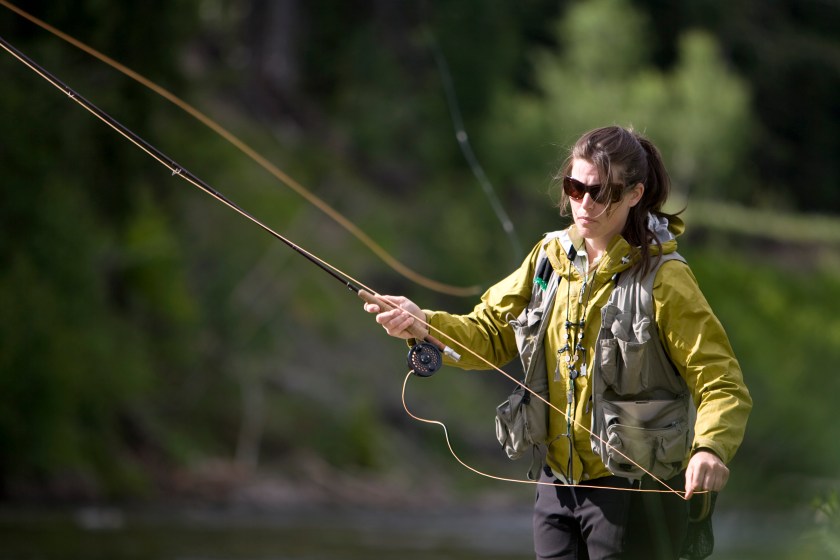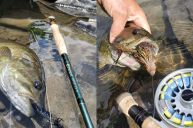You've purchased a fly rod. And maybe even a few artificial flies and a pair of fishing waders. But as you chat with seasoned fly fishers, you become aware of terms you don't recognize—words such as "tippet," "backing," and "fly floatant."
As with many sports, fly fishing has its own vocabulary. So even if you've fished with conventional tackle for years, you may find yourself scratching your head. That's why we created this guide to help better understand the equipment, techniques, and tackle you'll use on the water.
Fly Fishing Tackle Terms

JMichl/Getty Images
Rod Weight
Different types of fishing and different species of fish require a specific type of fly rod, and those are categorized based on a term called "weight." Weight ranges from 0 to 12, and each is designed for a specific type of fishing. This numbered system has nothing to do with physical weight but instead is a measurement for the size of the line it can cast.
Smaller numbers, such as 0 to 3, are for fishing on tiny mountain streams where finesse is required. Rod weights of 4 to 6 are more common for general trout fishing and other smaller fish. And the higher numbers, 7 to 12, will be used to take on larger species—from bass to rainbow trout and steelhead trout, and even saltwater trophy fish.
Fly Line
As you may already know, casting refers to the motion made when you throw your line forward into the water. You'll cast a "fly line" when you use a fly rod. The fly line is much heavier and thicker than conventional fishing lines because the line's weight allows it to carry light flies to your target on the water. Like fly rods, fly lines are categorized by "weight," from 0 to 12. Generally, you need to match the size of the fly line with the rod size. So if you buy a 4-weight rod, you'll need a 4-weight line.
Most fly line is weight-forward, meaning the line is tapered to be thicker so it's easier to cast. Most trout anglers use a floating line, which sits on the water's surface. For some saltwater fly fishing and freshwater fishing, sinking lines can be used to reach deeper fish.
Action
This term describes a fishing rod's flexibility, which corresponds with how it casts. There are typically three action categories: fast, medium, and slow. Fast-action rods are stiffer, while slow-action rods are flexible. And each is designed for a specific fishing style—typically, fast rods are better for larger fish species and heavier cover, and slow rods take smaller hooks and bait.
Drag
Drag most commonly refers to how fast the line unwinds from the fly reel. In simple terms, drag functions like the brakes in a car, slowing the rotation of the spool, which is critical to bringing the fish in slowly and smoothly. In fly fishing, drag can also refer to the current's effect on the fly line, creating an unnatural movement for the fly.
Backing
Backing is the last bit of line attached to a fly reel. It connects to the fly line and is designed to keep a fish on if it exhausts the available fly line. Backing comes in various materials and lengths, depending on the type of fish you're targeting.
Leader
A leader is used to connect the fly line to the fly. Most leaders are tapered and made from monofilament. A leader's thick "butt section" attaches to the fly line. It tapers to a thin portion tied to the fly, known as the tippet.
Tippet
The tippet is the thin portion of a leader that attaches to the fly. The tippet can be changed based on the circumstances an angler faces. Sizes vary based on fish species and fly size. Tippet size ranges from .015 (for larger flies) to 8X (for the smallest flies).
Strike indicators
Strike indicators are used on wet flies (see below)—typically nymphs, which are immature insects—to help anglers detect fish strikes. They come in multiple materials and patterns, and are attached to leaders.
Fly Fishing Fly Names
Dry Fly
A dry fly is an artificial fly that imitates insects and floats on the surface of the water. Dry flies can be tied to look like common streamside species, which vary based on location. Fishing with dry flies can be challenging because if they don't move naturally, the fish won't bite. However, dry flies can produce some of the most exciting moments when you get a hooked fish.
Wet Fly
A wet fly is a type of fly that's submerged in the water. For trout, wet flies are typically nymphs tied to look like immature aquatic insects. Wet flies also include streamers—aka, larger flies designed to look like minnows and other active species living in the water. Streamers may be used in trout streams and for bigger fish, such as bass and saltwater species.
Fly Floatant
This chemical substance or powder is applied to waterproof a dry fly and make it buoyant.
Fly Box
Simply put, a fly box is a storage device for organizing flies.
Fly Fishing Casting Techniques
Fly Casting
This is the act of throwing the fishing line and the lure over the water.
Backcast
The backcast motion carries the line behind the angler and is used to create momentum for the subsequent forward cast onto the water.
Forward Cast
The forward cast is completed when an angler shoots the line in front of them after a backcast.
False Cast
A false cast occurs when an angler casts a fly line in the air. It's used to generate momentum to cast a fly or sometimes to dry off a water-soaked fly.
Mending
Mending is a technique for lifting casted lines off the water when the angler flips the line using the rod tip to form a semi-circle loop. It results in a more realistic fly presentation by eliminating the current's drag on the line.
Roll Cast
The roll cast is commonly used in situations when a backcast may be limited due to obstructions. It's performed by pointing the rod tip up and flicking the line forward for a short cast.
Double Haul
A double haul is when you quickly strip line from the reel during the casting motion, allowing for a longer cast.
Stripping Line
This is when you retrieve your line by hand. Some flies, such as streamers, are stripped to create action during the presentation. An angler may strip the line during the fight for smaller fish instead of engaging the reel.
Fly Fishing Terms When on the Water

MichaelSvoboda/Getty Images
Presentation
Presentation is the way a fly is "presented" to fish in the water and varies widely based on fly selection and target species.
Dead Drift
A dead drift is when you allow the fly to bob along with the current, making it appear more natural to the fish. The technique is used in nymphing and dry fly fishing.
Rise
The "rise" describes the behavior of a fish when it comes to the surface to take a feed or take a dry fly. It usually gives an angler a view of the fish to determine its size and/or movement pattern.
Other Ways to Learn the Lingo
These terms are just a few of the basics to give you some insight into the language of fly fishing. It's by no means all-inclusive; and as you dive deeper into the sport, you'll learn even more niche terms that apply to specific styles and methods of fishing.
There are many ways you can grow your fly fishing vocabulary. Book a guided trip. Go to your local fly shop and ask questions. Check out online resources such as Orvis' Fly Fishing Learning Center. Hit the water with someone who's a veteran fly angler.
Over time, speaking the language of fly fishing will be as second nature as fly tying and your roll cast.
READ MORE: Fly Fishing 101: The Essential Gear Every Beginner Needs




